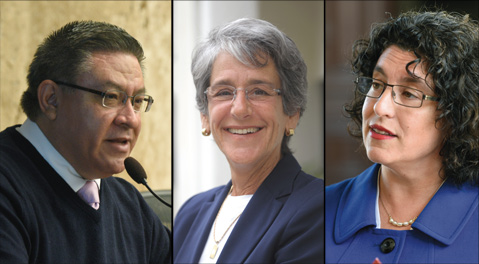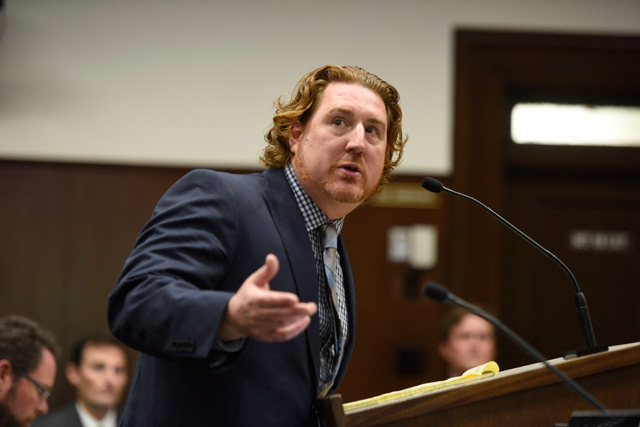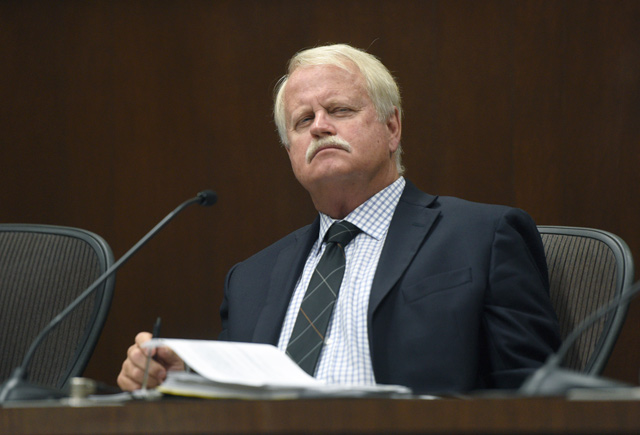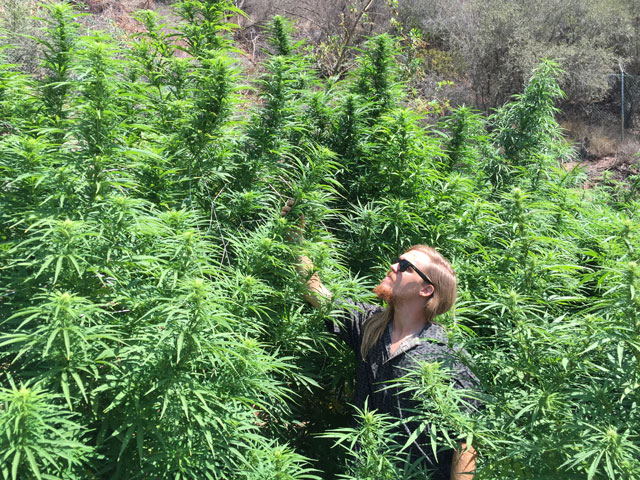Santa Barbara and the Pot Prop
Is It High Time California Legalizes Marijuana?

This November, exactly 20 years after California became the first in the union to decriminalize medical marijuana, state voters will decide once and for all if they can get high for fun, legally.
Four other states and the District of Columbia have already passed recreational cannabis laws, but if Proposition 64 is approved in California — the sixth largest economy in the world where marijuana is the biggest cash crop — it will send waves of drug-policy sea change across the country.
The creators and supporters of Proposition 64, the Adult Use of Marijuana Act, or AUMA, say the ballot measure will finally legitimize an activity in which millions of Golden State residents already partake. They argue that taxing and regulating the commodity will create a tax boon of a billion dollars a year, benefiting youth programs and law enforcement, and that the new state oversight will set quality-control and pricing standards that would edge out Mexican cartels.
Opponents, however, say the initiative would expose more children to a gateway drug, flood the roads with stoned drivers, and actually increase black-market activity. More immediate is the fact that marijuana remains classified as a Schedule I drug by the Federal Drug Enforcement agency, which puts it in the same category as heroin and ecstasy. U.S. Senator Dianne Feinstein and many sheriffs and district attorneys have all come out against the ballot measure.
Nevertheless, Prop. 64 appears poised for voter approval — Lieutenant Governor Gavin Newsom, the California Medical Association, mega-rich tech philanthropist Sean Parker, and many others support it; the “Yes” campaign has vastly out-fundraised the “No” contingent so far, $11.7 million to $173,000; and the most recent polls showed 63.8 percent of respondents favor legalizing recreational marijuana. In 2010, California voters narrowly rejected a similar but less carefully crafted ballot initiative.
Not as measureable has been the steady cultural acceptance of marijuana as a viable medical aid and means for adult relaxation. The seeds of this revolutionary change, planted in the ’60s and ’70s, now seem to be bearing political fruit. In November, eight more states will decide whether to allow recreational or medical marijuana. That most certainly will widen the gap between state and federal marijuana laws, therefore increasing pressure on Congress and the next presidential administration to reconcile the conflicting policies.
Santa Barbara County would surely be affected by the AUMA, as it’s uniquely positioned to grow an even healthier marijuana industry than it already supports. Even now, farmland and greenhouses are being bought by Prop. 64 prospectors. The City of Santa Barbara’s relatively permissive laws allowing medicinal storefronts and delivery services have perhaps paved the way for a recreational sector. And as a tourist destination that boasts world-class wine and beachside sunsets, Santa Barbara may one day, too, be marketed as a premier destination for cannabis connoisseurs.
However, detractors say, all this could also portend the ill effects of a speculative market. Police officials and neighborhood activists point to the crime and lawsuits that came with the city’s initial gold rush of medical marijuana dispensaries, wiped out five years ago in a federal crackdown. Prop. 64 opponents in Santa Barbara also worry that the county and our cities will never see a dime of the new tax dollars that a ravenous state government will be collecting.
With election season underway, Santa Barbara’s politicians are starting to voice strong opinions on both sides of the issue, as it will be up to them whether recreational marijuana businesses are even allowed in their jurisdictions. The medical marijuana community is watching the ballot item with intense interest, curious how it will affect the price of medicine. And casual pot smokers, from those harking back to the 1960s to young adults who just became of legal age, are beginning to wrap their heads around the idea that they might soon be able to stroll into a store and buy a few joints.

•••
Prop. 64 supporters argue that marijuana would be subjected to many of the same restrictions as those put on alcohol. Only state-licensed businesses could sell it to adults 21 and older through established storefronts or delivery services. People 21 and older could smoke marijuana only at a private residence or permitted business. They could possess up to an ounce of the plant or eight grams of its concentrate (oil or hash), and grow a maximum of six plants in their homes. Smoking in public or while driving would be illegal. Any business that sold alcohol or tobacco would not also be able to sell marijuana. Similarly, businesses allowing on-site consumption could not also allow drinking alcohol or smoking cigarettes.
The initiative covers all forms of marijuana use, including vaping and edibles. It also acknowledges that weed is still illegal in the eyes of the federal government, but it states that the U.S. Department of Justice declared it would not prosecute businesses or individuals complying with state cannabis laws. Most significantly, Prop. 64 would allow city and county governments to ban all recreational marijuana businesses. Personal use and cultivation, as well as transport of marijuana between jurisdictions, could not be outlawed, however.
This entire regulatory framework would be overseen by a new state agency, the Bureau of Marijuana Control. It would issue permits for commercial cultivation, as well as manage quality-control inspections, labeling requirements, tracking procedures, and all the other governmental oversight that comes with selling an intoxicant. The bureau would also regulate medical marijuana.
Prop. 64 would place a state excise tax of 15 percent on retail sales of marijuana, and state cultivation taxes of $9.25 per ounce of flowers and $2.75 per ounce of leaves. The revenue generated — predicted to reach as high as a billion dollars annually — would be funneled to youth programs (60 percent), environmental cleanup of illegal grow sites (20 percent), and initiatives to reduce impaired driving and offset any negative public-health impacts created by the law (20 percent). Marijuana is already on track to become a $6.6 billion market in California by 2020, according to market research firms. The state currently accounts for nearly half of all pot sales in the country, both legal and illegal.
The Tax Foundation, a Washington, D.C.–based think tank, just reported weed revenues in Colorado and Washington have come in higher than expected. For the fiscal year ending June 30, Colorado collected $157 million in marijuana taxes, licenses, and fees, up 53 percent from a year earlier. Oregon collected more than $25 million by July 31, higher than the $18.4 million projected. If every state legalized pot and captured most of the black market, they’d collect a total of $18 billion a year, the Tax Foundation projected. That’s the same amount tobacco taxes generated in 2013.
Sheriff Bill Brown, like many of his colleagues, thinks Prop. 64 is a terrible idea, despite all its promises. The enticement of tax revenue is a predictable formula used by public interest groups to win over voters, he said, but it is a drop in the bucket compared to costs of controlling the problems caused by the law.
Prop. 64 has been attacked for allowing marijuana ads on primetime TV, Sheriff Brown said. Children would be subjected to the Joe Camel effect of cartoon characters peddling pot in the middle of their favorite shows. The ballot argument against Prop. 64 stresses the advertising point more than any other. But proponents call the argument a red herring, explaining federal law, which regulates California’s TV and radio stations, still prohibits advertising a substance the DEA classifies illegal. The true legalities remain murky, and both sides were recently chided in court to tone down their ballot rhetoric on the subject.
For a predictor of what would happen on California’s roads and highways, Brown continued, look no further than what’s occurred in Washington and Colorado, where he said impaired driving rates spiked 48 percent and 36 percent, respectively, after those states legalized recreational marijuana. “It’s been a disaster all the way around,” he declared. Further, there isn’t a reliable way to determine if someone is driving high. Blood analysis doesn’t work, as THC can stay in a person’s bloodstream for weeks, and field sobriety tests are an imperfect science. Brown recalled a recent incident in Ventura where a stoned driver hit and killed a motorist stopped on the side of the road. “We have enough misery and tragedy from substances that are already legal,” Brown summed up. “We don’t need to make it easier to buy another intoxicant.”

Ed Stonefelt, president and CEO of the county’s Center on Alcohol and Drug Abuse (CADA), which has treated 5,000 students and their families at its youth addiction center during the last decade, has witnessed firsthand the detrimental effects of marijuana on young people who use and abuse it. He referenced a Northwestern University study that showed abnormal brain development in heavy pot users at a young age, which led to poor memory, paranoia, and schizophrenia. “Legalization does not equate to safe,” Stonefelt said of Prop. 64, which includes provisions aimed at protecting kids, such as keeping growing and smoking out of public view and prohibiting businesses from opening near schools. “That’s a false premise,” he complained, “because you’re simply making distribution and consumption easier. Prop. 64 would make [CADA] flourish, and that’s exactly what we don’t want to do.”
Dr. Cary Matsuoka, Santa Barbara Unified School District’s superintendent, has also seen too many students zombified by heavy marijuana use. Today’s potent product is nothing like the weed of the ’60s and ’70s. “Once they get to the point of self-medicating, they really struggle,” he said. “They really are no longer students. They become so preoccupied with smoking pot that they lose touch with reality.” It’s like a time-out from life, Matsuoka said, and checking out of school for a few months to a year creates a number of long-term consequences. Twenty percent of Santa Barbara Unified’s 11th graders admitted to using marijuana in a 2015 survey.
“I don’t think legalizing, essentially condoning, another intoxicating substance is good for public safety,” said District Attorney Joyce Dudley. For young people, marijuana is too often a gateway drug, she said, and the public cost of dealing with addiction problems and the crimes they engender “will far outweigh any possible tax revenue.” Dudley also believes Prop. 64 would ultimately help cartels, as a taxed product will inevitably create a market for cheaper, untaxed alternatives.
In the last 10 years, the Santa Barbara District Attorney’s Office has dealt with more than 4,200 cases that included one or more marijuana charges. The AUMA would mandate the resentencing of individuals arrested for marijuana offenses now made legal. To reopen those cases would mean a lot of extra work for the department, said Deputy District Attorney John Savrnoch. “You are revisiting an issue that was previously resolved and adding it to an already busy court calendar,” he said.

•••
For supporters of the Adult Use of Marijuana Act, temporary inconvenience to the government is a small price to pay after what they lament as decades of failed drug policy. Goleta City Councilmember Michael Bennett supports the proposition. “The war on marijuana has been an absolute, abject failure,” he said. “We’ve spent billions and incarcerated untold people, and for what?” If history has taught us anything, Bennett said, referencing Prohibition, it’s that such blanket criminalization does not work.
Goleta currently has two medical marijuana dispensaries, both grandfathered in when the city put a moratorium on additional storefronts in 2009. The councilmember doesn’t think recreational businesses, in Goleta or anywhere else, would inspire crowds of new users, as some opponents predict. “They won’t make people start smoking,” he said. As a younger man, Bennett partook. “I did smoke, I did inhale, and I enjoyed every minute of it.” He doesn’t anymore, but if the mood strikes, he’d consider taking another drag. Still, he’s not rushing to the first store that opens, and he doesn’t see many other people doing that, either.
Nationwide, pot use among teens peaked in the late 1990s and has been declining ever since, according to the Centers for Disease Control and Prevention. Abuse rates across all age groups have been falling since 2002. Contrary to early prognostications, teenage use rates did not increase in either Washington or Colorado after marijuana was legalized in both states in 2012, their health departments have reported.
Bennett is joined in his Prop. 64 opinion by a number of other Santa Barbara lawmakers. First District Supervisor Salud Carbajal, now running for Congress, said the current prohibition on marijuana “has wasted tax dollars and ruined countless lives.” A careful rollout of the law with clear guidelines and monitoring will “ultimately benefit our state,” he said. State Senator Hannah-Beth Jackson said the AUMA would “really just be legalizing something that’s been going on for a long time. … For young people, this train left the station long ago.” Santa Barbara Mayor Helene Schneider said she agrees with Lt. Governor Newsom’s long list of arguments in favor of legalization. “It makes a lot of sense,” she said.

Randy Rowse finds less logic in the law, which he called more emotional than practical. “People are in denial about pot,” he said. “It causes real harm.” If there’s to be anything gained from the AUMA, he went on, it’s an admittance that medical marijuana collective laws have been “a joke.” While some palliative care patients may legitimately need cannabis, the system was too often gamed by teens looking to toke up, he said. Rowse, who owns the Paradise Café and Bar, and whose wife is an outspoken critic of all things marijuana, conceded alcohol has produced a lot of pain and heartache around the world. Still, he said, weed shouldn’t be treated so cavalierly.
State Assemblymember Das Williams said, if done correctly, legalization could deny drug cartels their largest source of revenue. That would require a sophisticated tracking system to ensure marijuana sold in California stores wasn’t actually grown south of the border. But Williams said he isn’t sure if the state is capable of implementing such a safeguard at the moment.
The stakes may be highest in Supervisor Doreen Farr’s 3rd District. “I know the agricultural community is very interested in this,” she said. “It’s a big deal.” Farr and others have heard of land grabs taking place up and down the coast. Growers hoping to corner the recreational market early are leasing and buying up North County farmland and Carpinteria greenhouses at a rapid rate. Farr recently met with two young entrepreneurs lobbying her to support their proposed operation.
The worry, Farr explained, is that marijuana could one day become Santa Barbara’s main cash crop to the detriment of its other harvests. “Agriculture always has to be nimble and flexible to get the most dollars per acre,” she said. “And it will be hard to beat marijuana.” Eventually, if a recreational weed market becomes deeply rooted, strawberries and broccoli will grow scarce, and their prices would shoot way up. “That really does concern me,” said Farr.
County planner Allen Bell confirmed his office is regularly receiving inquiries from people looking to build commercial operations. But Bell then explained how Santa Barbara County adopted regulations in January that prohibit the cultivation and processing of medical marijuana. Long-standing grow sites that have conformed to the state’s Compassionate Use Act were allowed to stay, but the county put the kibosh on any new pot farms. The working theory among county officials is that entrepreneurs say they’ll be growing medicinal marijuana when in fact they have every intention of switching to recreational after November.
The county Board of Supervisors hasn’t discussed Prop. 64 yet. Even if the AUMA is voted in, state licenses for nonmedical marijuana businesses and cultivation sites won’t start being issued until 2018. Still, given the potential implications, Supervisor Janet Wolf hopes that “we’ll be proactive with this.”

•••
When Santa Barbara County’s medical marijuana dispensaries started withering under federal crackdowns in 2011 and 2012, delivery services became the only means by which patients, real or pretend, could receive their cannabis. Since then, these distribution operations have flourished, mostly under the radar. They’re technically regulated by 20-year-old state law, but they receive very little oversight and are considered a low priority among local law enforcement. Under the package of pending medicinal regulations signed into law last year, called the Medical Marijuana Regulation and Safety Act, they will be more tightly governed. Under the AUMA, nonmedical deliveries would be allowed but only through state-licensed businesses.
Zach Schaefer has helped run Evergreen Compassionate Care since 2013, supplying 2,200 Santa Barbara area patients with marijuana. He estimated there are approximately 40 delivery services sprinkled throughout the county, only a handful of which actually abide by state rules, have a license, and pay their taxes. He’s one of them. A search of weedmaps.com, the Yelp of the medical marijuana world, confirms Schaefer’s overall estimate, with dozens of cannabis runners from Lompoc to Carpinteria advertising all manner of strains, edibles, and tinctures.
Schaefer doesn’t know where he lands on Prop. 64. “On one hand, it will benefit patients by creating a more stable atmosphere,” he said. “On the other hand, medicinal marijuana will be taxed to pay for the costs of testing and controlling nonmedical.” That, Schaefer said, could drive up prices for patients. In the meantime, he’s busy fielding daily solicitations from growers who want him to buy and distribute their product. “I have to fight them off with a stick,” he said.
Zach Pitts with Goddess Delivers is wholeheartedly excited about Prop. 64. “It’s something we desperately need,” he said. “It’s funny to be in an industry where you’re crying out for authorities to regulate you.” The AUMA would “create jobs and prosperity,” Pitts said, and finally establish a set of clear laws that protect patients and their providers. “In Washington and Colorado, it was stunning how people got on board when they knew they wouldn’t be raided for following the rules,” he said.
Goddess Delivers, based in Southern California, distributes anywhere in the state overnight. Many of its patients, older and with a preference for front-porch service, live in Santa Barbara. Pitts predicts if Prop. 64 passes, the availability of recreational marijuana will spark a bit of novelty and nostalgia for a short time and then quickly become passé, based on what he’s seen in Washington and Colorado. “For the first six months to a year, baby boomers will walk into a store and get their minds blown,” he said. “After that, it’s just another way to have a little fun in the privacy of your own home.’”
Ryan Howe is poised to open the first medical marijuana dispensary, at 118 North Milpas Street, since the crackdown thanks to the City Council voting six years ago to permit three medical storefronts. He said he has no desire to wade into the recreational pool, which he thinks will get crowded and messy when Big Marijuana takes over the market. “It’s going to be Miller beer versus Budweiser beer,” he predicted.
Howe hopes casual on-site consumption isn’t allowed at dispensaries or stores. “I think marijuana is medical, so it should be treated that way.” And he’d like owners to use a high degree of care in deciding what they offer. “I don’t think gummies or candies or anything that a kid could mistake for a treat should be in the world of marijuana,” he said. Right now, mobile delivery services are selling Froot Poofs with pictures of Tokin’ Sam, as well as rice crispy treats and ice cream push pops laced with THC. For that reason, and a few others, Howe isn’t sure he’ll vote for the AUMA. He also scorned high-octane products that would catch many users by surprise — “moon rocks” are a hunk of marijuana coated with concentrated oil and sprinkled with kief, the dry resin of cannabis flowers. “It’s like taking an acid hit,” Howe said.

•••
As Howe prepares for the grand opening of his dispensary, Canopy, in the coming months, he’ll also be watching a city measure on November’s ballot that will ask voters whether they want to slap a 20 percent tax on medical and — if Prop. 64 passes — recreational cannabis sold within Santa Barbara. City Hall estimated the Santa Barbara Marijuana Control Act would annually generate an estimated $1.1 million-$2.2 million a year for the General Fund, which pays for basic services such as police enforcement and road repair. Earlier this year, the city approved an ordinance that permits qualified medical marijuana patients to grow 100 contiguous square feet of marijuana indoors or outdoors for personal use.
Currently, Santa Barbara is the only city in the entire tri-county area to permit medical dispensaries, a fact not lost on some councilmembers who think the city unwisely gave clearance to a type of purveyor they say attracts crime and costs a lot of money to enforce. Police spokesperson Sergeant Riley Harwood said while there wasn’t an increase in serious crime around the former iteration of dispensaries, they did generate complaints over parking and loitering. There were a few robberies, as well. Even more concerning, Harwood said, are the underground labs making concentrated marijuana with volatile chemicals. Explosions and injuries have occurred.
For years, enforcing low-level marijuana laws has been at the bottom of the police department’s to-do list, said Harwood. Officers still arrest dealers and make big busts, but the overall de-prioritization was brought about by new municipal code, limited resources, and subtle messaging from state and federal prosecutors that such cases are often more trouble than they’re worth. “Sometimes you’re doing a lot of investigation and work for a case that ends in probation,” said Harwood. Since 2010, Santa Barbara police have issued 1,772 misdemeanor citations for simple possession; they’ve made 165 felony arrests for sales and transportation.
If the AUMA goes on the books, Harwood expects his department will start fielding complaints from residents annoyed by their neighbors smoking and growing marijuana. Live plants themselves are quite pungent, Harwood noted, “and a lot of people take offense to the smell of others smoking around them.” From a legal standpoint, Harwood said, he isn’t sure what officers will be able to do in those situations.
The Sheriff’s Office still spends considerable resources on marijuana-related crimes that are a real threat to public safety — since 2010, the department has recovered or apprehended 30 panga boats carrying 41,000 pounds of Mexican weed. Last year alone, it eradicated 43,000 plants in illegal backcountry grows, which are often tended by gun-toting cartel members. The Soberanes Fire that scorched more than 67 square miles of Big Sur forest and killed one person was started by an abandoned campfire at an illegal grow.
Over the last six years, the Sheriff’s Office has made 1,465 misdemeanor arrests and 843 felony apprehensions for marijuana crimes. Prison sentences can result from simple possession charges, but those cases are exceedingly rare, and are often the result of a parole or probation violation. The U.S. Justice Department estimated that 3.6 percent of state prison inmates in 2013 had drug possession as their most serious offense, but that includes all drugs, not just marijuana. NORML (National Organization for the Reform of Marijuana Laws) has said there are 50,000-110,000 cannabis-only offenders in prison throughout the United States, most for cultivation, sales, or trafficking.
Last Tuesday, the Santa Barbara City Council took early steps toward implementing an emergency ordinance that would prohibit the local licensing of nonmedical marijuana businesses for two years while Santa Barbara gets used to the idea of Prop. 64, if it passes. “This would give us maximum flexibility,” said Mayor Schneider. Staff needs time to study the measure. The vote to approve the ordinance, which needs ayes from six of the seven councilmembers, is set for mid-October.
With an election in November 2017 for three council seats and the mayor’s position, it’s difficult to predict how Santa Barbara’s decision makers will regard nonmedical marijuana in the coming years. Residents have proved relatively tolerant of cannabis on the whole — in 2010 they voted down with gusto a measure that would have banned dispensaries outright — but whether those same views will survive on the dais is hard to say. And if past intense debates on the subject are any indication, Santa Barbara is in for another wild ride. “This is something we need to get ready for,” said the mayor.


